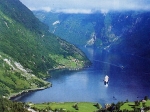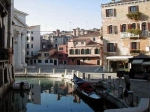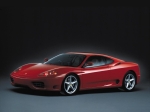 The Republic of Slovenia ( Slovenian : Slovenija ) is a coastal sub-Alpine country in south central Europe bordering Italy to the west, the Adriatic Sea to the southwest, Croatia to the south and east, Hungary to the northeast, and Austria to the north.
The Republic of Slovenia ( Slovenian : Slovenija ) is a coastal sub-Alpine country in south central Europe bordering Italy to the west, the Adriatic Sea to the southwest, Croatia to the south and east, Hungary to the northeast, and Austria to the north.
Geography
Four major European geographic regions meet in Slovenia: the Alps , the Dinaric area, the Pannonian plain , the Karst region and the Mediterranean . Slovenia's highest peak is Mt. Triglav (2864 m); the country's average height above the sea level is 557 m. Around one half of the country (10,124 km²) is covered by forests; this makes Slovenia the third most forested country in Europe, after Finland and Sweden . Remnants of primeval forests are still to be found, the largest in the Kocevje area. Grassland covers 5593 km² of the country and fields and gardens 2471 km². There are also 363 km² of orchards and 216 km² of vineyards.
Its climate is Mediterranean on the coast, Alpine in the mountains and continental with mild to hot summers and cold winters in the plateaus and valleys to the east. The average temperatures are -2°C in January and 21°C in July. The average rainfall is 1000 mm for the coast, up to 3500 mm for the Alps, 800 mm for south east and 1400 mm for central Slovenia.
Economy
Slovenia continues to enjoy the highest GDP per capita of the transitioning economies of the region. The country is experiencing an increased, yet manageable, rate of inflation and anticipates increased GDP growth during the year 2000 as growth accelerates in the EU , Slovenia's leading export market. The country is on a sound economic footing. However, much work remains to be done in the areas of privatisation and capital market reform.
During 2000, privatisations were seen in the banking , telecommunications , and public utility sectors. Restrictions on foreign investment are slowly being dismantled, and foreign direct investment (FDI) is expected to increase over the next two years. Slovenia can be considered one of the economic front-runners of the countries that joined the European Union in 2004 .
Demographics
Slovenia's ethnic groups are: Slovenians (89%); Croats , Serbs , Bosniaks and other nationalities of the former Yugoslavia (10%); and the ethnic Hungarian and Italian minorities (0.5%). Life expectancy in 2000 was 71.80 years for men and 79.50 years for women.
With 95 inhabitants per km², Slovenia ranks low among the European countries in population density (compare with 320/km² for the Netherlands or 195/km² for Italy ). Approximately 50% of the total population lives in urban areas, the rest in rural.
The official language is Slovenian , which is a member of the South Slavic language group . Hungarian and Italian enjoy the status of official language in the nationally mixed regions along the Hungarian and Italian border.




